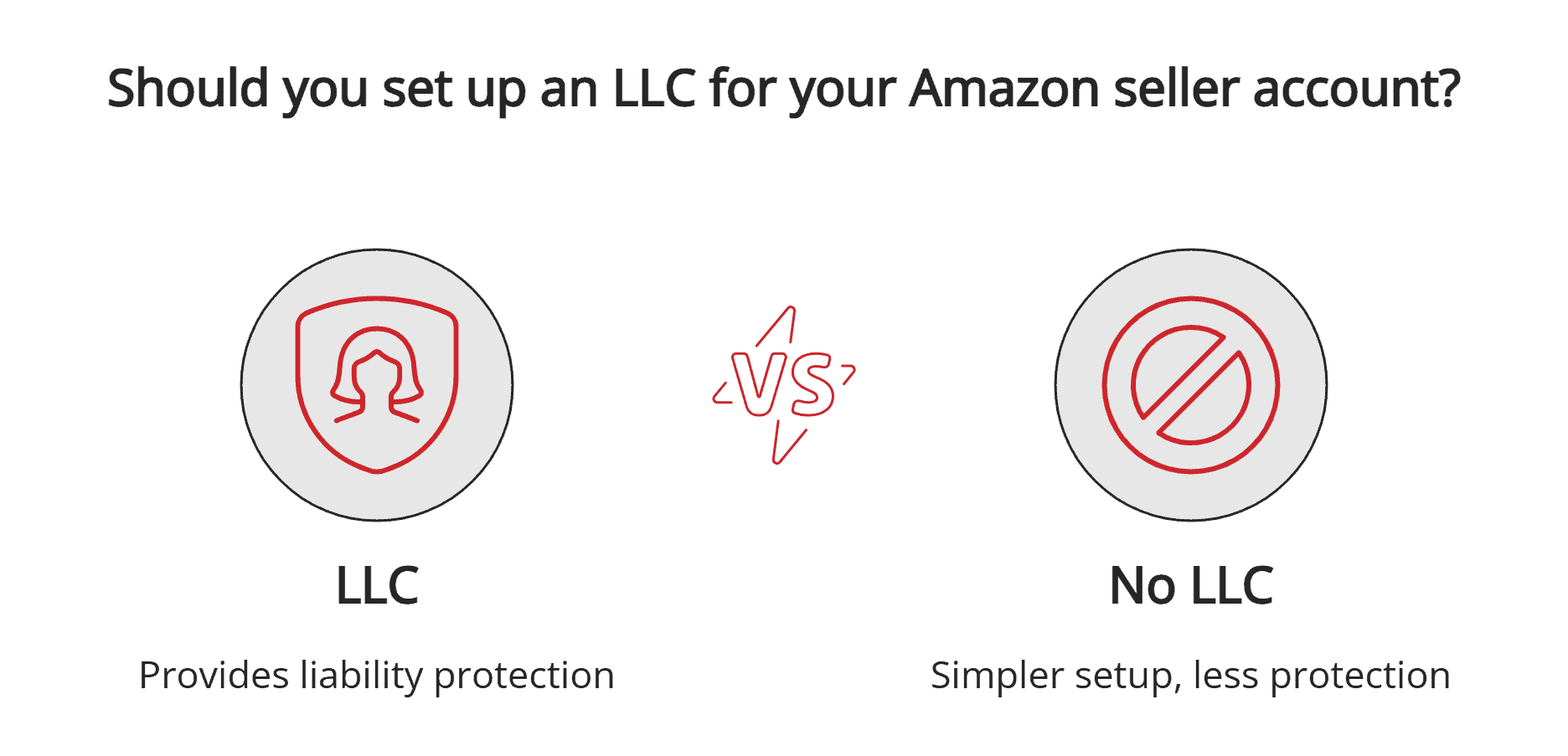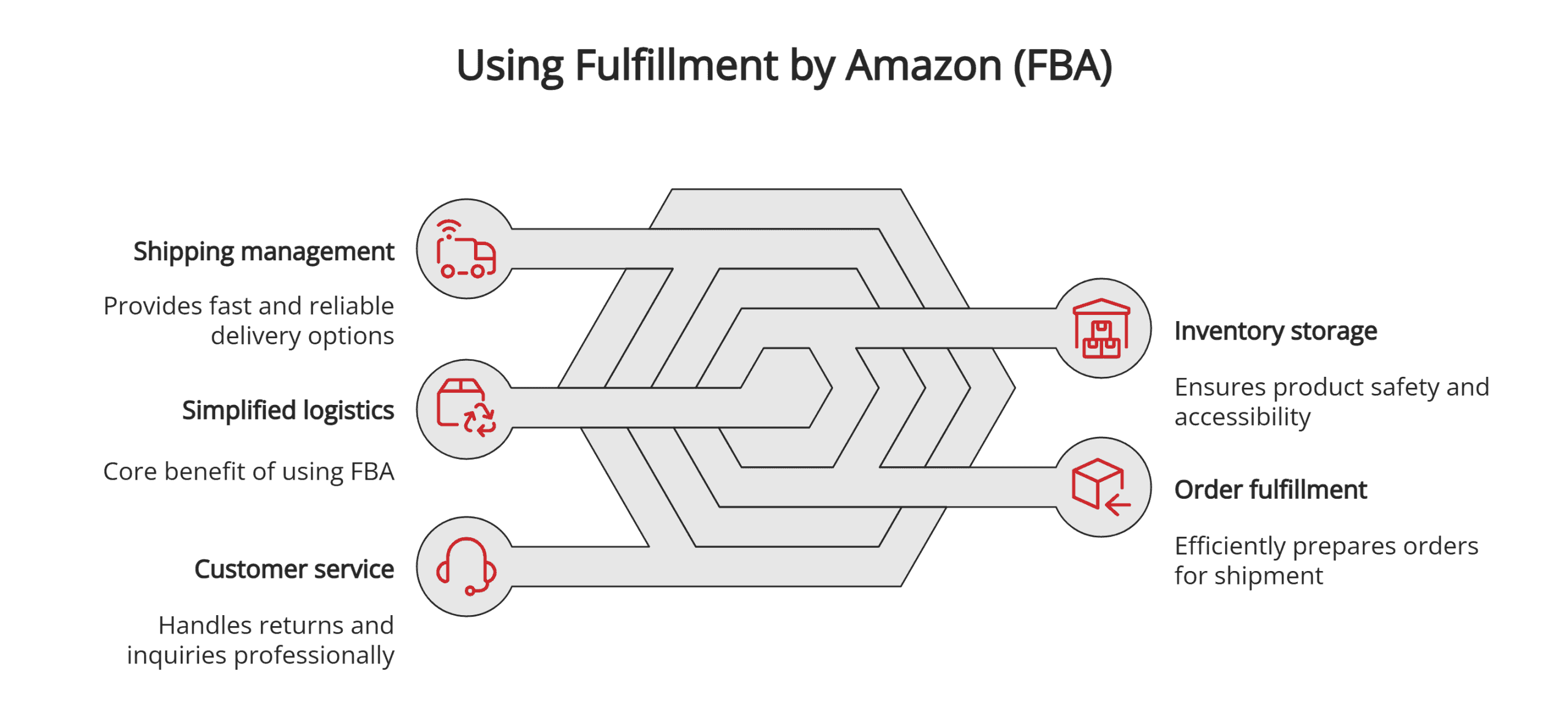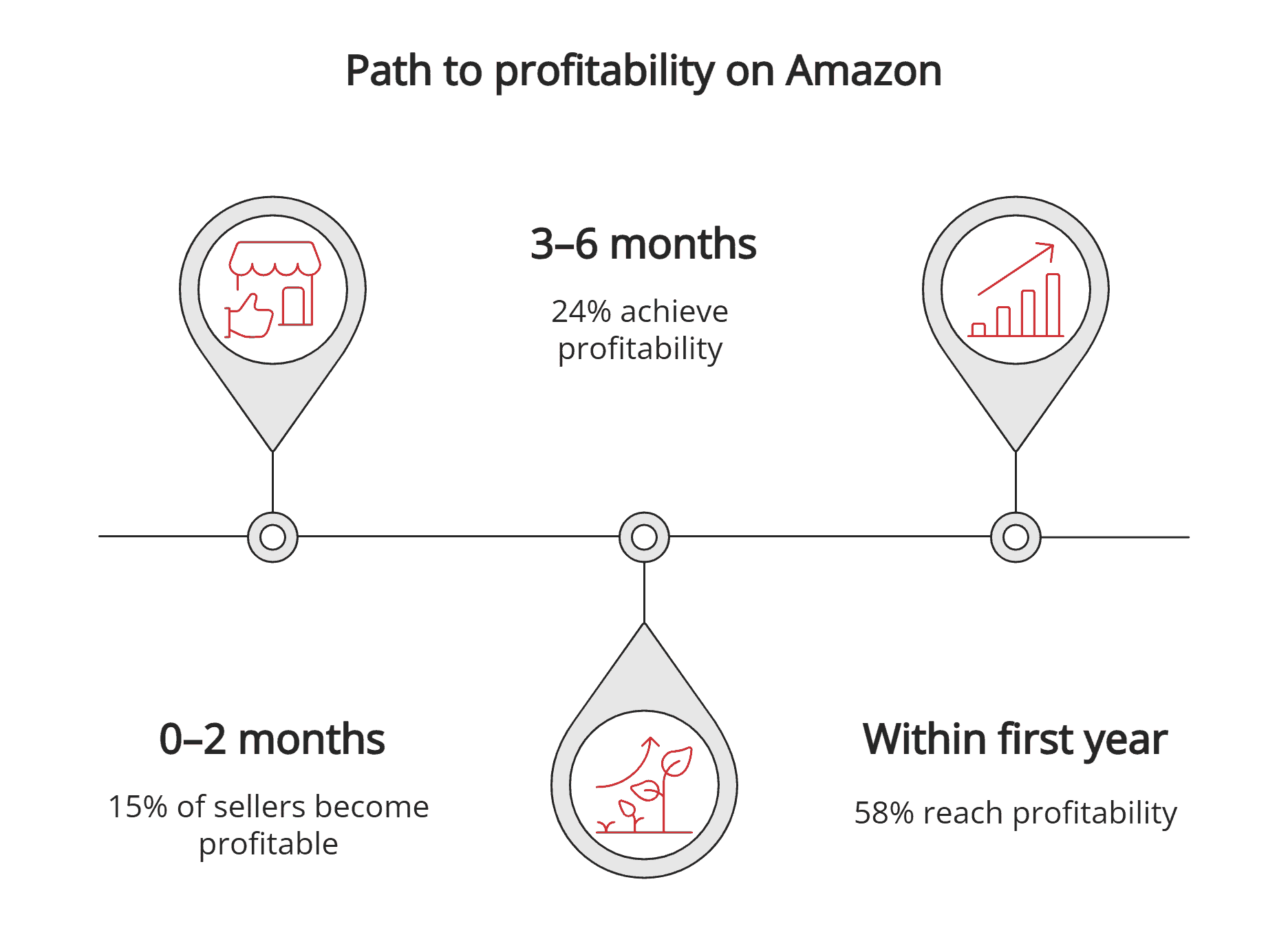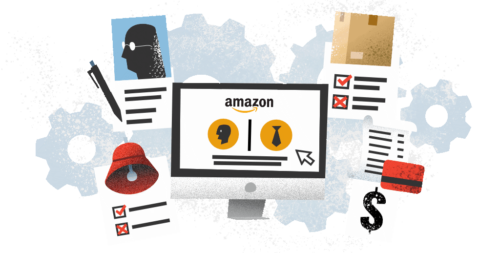You can list your first product on Amazon in under a week for less than $500. But here’s what nobody mentions in those “Amazon success story” videos: most sellers never turn a profit.
The real answer: Starting is simple. Staying profitable is hard.
Amazon provides the infrastructure—massive traffic, world-class fulfillment, and built-in customer trust. You provide the business strategy, product differentiation, and capital management.
Success depends on treating this like a real business, not a side hustle.
What you’ll learn

The real-world steps to get your first product live

A data-backed look at the costs and time commitment

The “easy” parts that attract sellers and the “hard” parts they often miss

A decision framework to see if Amazon is right for you
TL;DR:
Key takeaways

Selling on Amazon is simple to start but hard to master

Profitability depends on product choice, managing fees, and marketing

Using Fulfillment by Amazon (FBA) is a major advantage, but it has costs

Success is a result of planning and business acumen, not luck
Quick answer: the short truth
Is it easy to sell on Amazon?
Starting is straightforward—you can create a Professional seller account for $39.99 per month and get a product live within weeks. However, becoming profitable is challenging due to intense competition, complex fees, and strict policies that require careful navigation and business strategy.
Key takeaways:

Simple setup: Creating a Professional seller account costs just $39.99/month, and getting a product live can take just a few weeks

High competition: With 82% of sellers using FBA, standing out in a crowded market is the main challenge

Fulfillment is solved (with FBA): Logistics can be easy, but they come at a cost

Profitability is the true hurdle: While 58% of sellers are profitable in their first year, success depends on managing costs and business strategy, not just listing a product
Many Amazon seller accounts struggle in their first year because they underestimate these challenges. The path to start selling on Amazon may be simple, but building a sustainable business requires dedication and strategic thinking.
PRO TIP: Think of Amazon as opening a store in the world’s busiest mall. Getting your doors open is easy—staying profitable while paying rent and competing with thousands of neighbors is the real challenge.
How the Amazon selling process works
Getting started on Amazon follows a predictable path from idea to first order, but understanding each step helps set realistic expectations.
The process centers on two main pillars: setting up your store in Seller Central and managing your products and orders. These systems work together to create your Amazon business foundation.
Account setup & verification involves creating an Amazon seller account through Amazon’s Seller Central platform. While Amazon doesn’t require an LLC, it’s highly recommended for liability protection. The verification process typically takes 24–48 hours and requires basic business information and tax details.

Choosing your selling plan comes down to the Individual versus Professional selling plan. The rule of thumb is simple: If you sell fewer than 40 units per month, the Individual plan works fine. If you exceed that threshold, the Professional plan at $39.99/month becomes cost-effective and unlocks advanced selling tools.

Deciding on fulfillment represents your biggest strategic choice. Fulfillment by Amazon (FBA) handles storage, picking, packing, shipping, and customer service for you, making it the “easy” option, though it comes with substantial fees. Fulfillment by Merchant (FBM) gives you complete control but requires managing every aspect of order fulfillment yourself. High-performing sellers can eventually qualify for the rigorous Seller Fulfilled Prime (SFP) program, which combines the control of FBM with the Prime badge benefits.
Listing your product requires creating a product detail page with an ASIN (Amazon Standard Identification Number), compelling title, bullet points highlighting key features, high-quality images, and competitive pricing. This listing becomes your virtual storefront within Amazon’s massive marketplace.

Managing orders & shipping varies dramatically based on your fulfillment choice. With FBA, Amazon handles everything after you send inventory to their warehouses. With FBM, you receive order notifications, pick and pack items, print shipping labels, and handle customer service inquiries directly.
NOTE: The technical setup is genuinely straightforward—most sellers can complete the entire process in a weekend. The complexity emerges in product selection, competitive positioning, and long-term profitability management.
What makes selling on Amazon “easy”
Amazon’s built-in infrastructure genuinely simplifies many aspects of ecommerce that would otherwise require significant investment and expertise.
Massive customer base provides immediate access to shoppers without the need to build an audience from scratch. Amazon attracts 51% of all online shoppers, creating a ready-made market for your products. This eliminates the costly and time-consuming process of driving traffic to your own website through advertising and content marketing.
Simplified logistics with FBA removes the biggest barrier for new sellers. Fulfillment by Amazon handles inventory storage in climate-controlled warehouses, picks and packs orders with professional materials, manages shipping with fast delivery options, and provides customer service for returns and inquiries. This comprehensive solution means you can run a fulfillment business without owning a warehouse, hiring staff, or learning complex logistics.

Borrowed trust & credibility come automatically through Amazon’s platform. The Prime badge instantly signals fast, reliable delivery to customers. Amazon’s A-to-Z Guarantee protects buyers, making them more comfortable purchasing from unknown sellers. This trust takes years to build independently but is available immediately on Amazon.
Powerful advertising tools through Amazon’s advertising console allow targeted reach at the exact moment customers are ready to buy. Unlike social media advertising, where you interrupt people, Amazon ads reach customers who are actively searching for products like yours. The platform provides detailed analytics and allows precise budget control.

Brand protection through Amazon Brand Registry helps protect your intellectual property while building customer trust. Enrolled brands gain access to enhanced content tools like A+ Content, which allows rich media descriptions that can significantly improve conversion rates.
For the aspiring Amazon seller, these advantages represent genuine opportunities to build a scalable business with less upfront infrastructure investment than traditional retail models.
The hard parts no one tells you
Behind Amazon’s appealing facade lurk challenges that catch many new sellers off guard and can quickly turn dreams of easy money into expensive lessons.
Intense competition & price wars define the current Amazon landscape. You’re competing not just with other third-party sellers but sometimes with Amazon itself through their private label brands. Popular products often have dozens of sellers, leading to price wars that can eliminate profit margins overnight. Amazon’s algorithm typically favors the lowest price, creating pressure to continually reduce margins to maintain visibility.

Strict & shifting policies create constant compliance challenges. Amazon can suspend your account with little warning for policy violations, often interpreting rules in ways that seem arbitrary. Policy changes happen frequently, and what worked yesterday might violate today’s terms of service. You’re essentially building your business in someone else’s sandbox, where they can change the rules at any time.
The “death by a thousand fees” slowly erodes profitability through multiple charges. Referral fees typically range from 8–15% of your selling price. FBA fees include storage, fulfillment, and long-term storage charges that can quickly add up. Peak season surcharges, removal fees, and various other costs create a complex fee structure that’s difficult to predict and manage.

Black hat tactics & sabotage represent real threats that ethical sellers must defend against. Competitors may hijack your listings, leave fake negative reviews, or file false intellectual property claims to get your products removed. These tactics are, unfortunately, common and can devastate your business while you work through Amazon’s slow resolution processes.

Inventory & cash flow management creates a challenging balancing act that many Amazon seller businesses struggle with. You must purchase inventory upfront, often months before sales, tying up significant capital. Too little inventory leads to stockouts that can permanently damage your search rankings. Too much inventory results in high storage fees and potentially dead stock. This cash flow challenge is a common failure point for many sellers. A good alternative is learning how to choose a 3PL partner to manage your FBM logistics.
ALERT: These challenges aren’t theoretical—they’re daily realities for Amazon sellers. Success requires treating Amazon selling as a serious business venture, not a get-rich-quick scheme.
Cost & time investment: What to budget
Understanding the true financial and time commitments helps set realistic expectations and prevents undercapitalization—one of the primary reasons Amazon businesses fail.
Startup cost breakdown varies significantly based on your approach, but most sellers need between $1,000–$5,000 to start selling properly. Here’s a realistic breakdown:
| Expense category | Low end | High end |
|---|---|---|
| Professional selling plan (annual) | $480 | $480 |
| Product samples & testing | $300 | $800 |
| Initial inventory order | $500 | $5,000 |
| Product photography | $200 | $1,500 |
| UPC codes & miscellaneous | $100 | $300 |
Ongoing fees & margins significantly impact your bottom line and must be factored into pricing decisions. Referral fees, FBA fulfillment costs, storage fees, and advertising expenses typically consume 25–40% of your selling price. A 15–20% net margin is considered standard, meaning you need substantial volume to generate meaningful income.
The timeline to profitability requires patience and persistence that many Amazon seller accounts don’t anticipate. Data shows that 15% of sellers become profitable within 0–2 months, 24% achieve profitability in 3–6 months, and 58% reach profitability within their first year. This timeline reflects the learning curve involved in product selection, listing optimization, advertising management, and operational efficiency.

Hidden costs and cash flow challenges often catch new sellers off guard. Beyond the obvious expenses, you’ll need to budget for product returns, storage fees during slow periods, and potential inventory write-offs. Many sellers also underestimate the advertising budget needed to gain initial traction, which can easily consume 20–30% of revenue in the early months.
Time investment reality extends far beyond listing products. Successful sellers typically spend 20–40 hours per week on research, inventory management, customer service, advertising optimization, and competitive analysis. This isn’t passive income—it’s active business management that requires consistent attention and strategic decision-making.
PRO TIP: Budget for at least six months of expenses without expecting significant income. Many promising Amazon businesses fail because sellers run out of money before achieving profitability, not because their products or strategies were fundamentally flawed.
Real-world data & seller stories
Data and real experiences provide crucial context for understanding what success and failure actually look like on Amazon.
The big picture reveals both the opportunity and the challenge. The average new seller makes $29,412 in annual profit, while 45% of sellers generate between $1,000–$25,000 in monthly sales. These numbers represent the successful sellers—the data doesn’t capture those who gave up before reaching profitability.
The cautionary tale illustrates common pitfalls. Consider a typical beginner mistake: a seller orders 1,000 units of a generic phone case for $5,000, expecting easy profits. Without proper product differentiation or marketing strategy, they get caught in a price war with dozens of other sellers. Unable to compete profitably, they’re left with $4,000 worth of dead inventory accumulating storage fees monthly. This scenario repeats thousands of times across Amazon, highlighting the importance of product research and differentiation.

The success snapshot shows what strategic selling looks like. One seller identified a gap in the ergonomic pillow market, specifically targeting side sleepers with neck pain. By investing in quality product development, professional branding, and targeted advertising, they achieved 25% profit margins and $50,000 in monthly sales within 18 months. Their success came from solving a specific problem for a defined audience, not from competing on price with generic products.
Should you sell on Amazon? A decision framework
This three-part self-assessment helps determine whether Amazon selling aligns with your goals, resources, and risk tolerance.
Part 1: The product fit checklist evaluates whether your product idea has genuine potential:

Is your product well-differentiated from existing options?

Can you achieve a 25%+ profit margin after all Amazon fees?

Is your product lightweight and not in a restricted category?

Do you have a clear value proposition that justifies your price point?
Part 2: The skills & resource audit examines your practical readiness:

Capital: Do you have $2,000–$5,000 to invest and potentially lose? Understanding what goes into 3PL pricing can help you budget for fulfillment costs if you choose the FBM route.

Time: Can you commit 20+ hours per week to launch and manage the business?

Skills: Are you willing to learn digital marketing, data analysis, and supply chain management?

Patience: Can you work for 6–12 months before seeing significant returns?
Part 3: The risk tolerance gauge measures your comfort with uncertainty:

How comfortable are you with potential financial loss?

Can you handle the stress of building a business on someone else’s platform?

Are you prepared to adapt quickly to changing policies and market conditions?

Do you have alternative income sources during the ramp-up period?
Making the final decision requires honest self-reflection about your motivations and capabilities. Many people are attracted to Amazon selling because they believe it’s easier than traditional business models, but the most successful Amazon seller operations treat it as seriously as any other enterprise. If you’re looking for passive income or a get-rich-quick solution, Amazon selling isn’t the right fit.
Your readiness indicators should align before you start selling:

You have adequate capital and can afford to lose your initial investment

You possess or are willing to develop the necessary business skills

You understand this is a long-term commitment, not a quick profit opportunity

You have realistic expectations about timelines and profit potential
ALERT: Be brutally honest in this assessment. Amazon selling rewards those who approach it as a serious business venture with adequate preparation, not those hoping for easy money with minimal effort.
5 tips to make Amazon selling easier
These strategies help mitigate common challenges and increase your chances of building a sustainable, profitable Amazon business.
Niche down to stand out in Amazon’s crowded marketplace. Instead of selling “water bottles,” focus on “insulated hiking water bottles with built-in compass for outdoor enthusiasts.” Specific targeting allows you to command higher prices, build brand loyalty, and compete on value rather than price alone.
Master your listing (SEO & A+ Content) by treating your product page like a high-conversion landing page. Use relevant keywords in titles and bullet points, invest in professional photography, and leverage A+ Content to tell your brand story. Well-optimized listings can double or triple conversion rates compared to basic listings.

Use FBM/3PL for bulky items when FBA economics don’t work in your favor. For large, heavy, or bulky products, partnering with a 3PL that offers big and heavy fulfillment can save you from massive FBA storage and shipping fees while maintaining professional fulfillment standards.
Build a brand, not just a listing, to reduce dependence on Amazon’s algorithm. Develop external traffic sources through social media, email marketing, and content creation. Brands with diverse traffic sources are more resilient to Amazon policy changes and algorithm updates.
Start small and test before making large inventory commitments. Begin with 200–500 units to validate demand and refine your approach before scaling up. This approach minimizes risk while allowing you to gather real market data.
PRO TIP: Focus on building systems and processes from day one. Successful Amazon sellers think like business owners, not product flippers, investing in tools, relationships, and knowledge that create long-term competitive advantages.
Alternatives & complements to Amazon
Amazon shouldn’t be your only sales channel—diversification creates stability and reduces platform risk.
Your own store (Shopify/DTC) provides complete control over the customer experience, data, and profit margins. While you must generate all traffic yourself, successful DTC brands often achieve higher customer lifetime values and stronger brand loyalty. Integrating your store with a top-tier Shopify 3PL is key to competing on shipping speed and reliability.
Other marketplaces offer different advantages for various product types. Walmart Marketplace provides access to value-conscious shoppers with less competition. eBay works well for unique or collectible items. Etsy serves the handmade and vintage market. Each platform has distinct audiences and fee structures.

The hybrid approach (omnichannel) leverages multiple Amazon stores alongside your own website to maximize reach while reducing risk. This diversification strategy protects against policy changes or account issues on any single platform. Success with this approach is best achieved through a robust omnichannel fulfillment strategy to keep inventory synchronized across channels.
NOTE: Start with one channel and master it before expanding. Trying to manage multiple sales channels simultaneously often leads to poor performance across all platforms rather than success on any single one.
FAQs about selling on Amazon
How much money do you need to start selling on Amazon?
Most sellers need $1,000–$5,000 to launch properly, though it’s possible to start selling with under $500 using models like retail arbitrage. The exact amount depends on your product choice, initial inventory order size, and whether you invest in professional photography and branding.
Do you need a business license or an LLC?
Amazon doesn’t require an LLC to create a seller account, but it’s strongly advised for legal protection and tax benefits. Some states require a business license for tax purposes. Consult with a tax professional or attorney to understand requirements in your specific situation.
Is Amazon FBA saturated?
In popular categories, competition is intense. Success requires deep niche research, product differentiation, and strong marketing. With 82% of sellers using FBA, you’re competing with sophisticated sellers who understand the platform well.
What are the biggest beginner mistakes?
The most costly mistakes include choosing oversaturated products without differentiation, underestimating the total cost structure, including all fees, and ordering too much inventory upfront before validating demand. Many beginners also neglect to build external traffic sources, making them entirely dependent on Amazon’s algorithm.
Are there hidden fees?
Amazon’s fees aren’t hidden, but they’re complex and numerous. Beyond the obvious referral and FBA fees, sellers must account for storage fees, long-term storage surcharges, removal fees, advertising costs, and various penalty fees for policy violations.
Can you still make a profit with private label in 2024?
Yes, but it requires more capital, better marketing, and stronger differentiation than in previous years. The average profit margin is 15–20%, and successful sellers typically focus on solving specific problems for defined audiences rather than competing on price with generic products.
Final verdict & your next step
“Easy” is the wrong word to describe selling on Amazon. “Systematic” and “possible” are more accurate. Success for an Amazon seller results from research, planning, and management—not luck. To sell on Amazon successfully means running a real business with all the challenges and rewards that entail.
Amazon provides unprecedented access to customers and infrastructure, but these advantages come with intense competition and complex challenges. The sellers who succeed treat Amazon as one component of a broader business strategy, not a get-rich-quick scheme.
The decision framework in this guide helps you honestly assess whether Amazon selling fits your goals, resources, and risk tolerance. If you’ve identified that you have the necessary capital, time, and commitment, Amazon can be a viable path to building a profitable business.
Your next steps depend on your assessment results:

If you’re ready to proceed, start with thorough product research and competitive analysis

If you need more capital or skills, focus on building those resources before launching

If the risks seem too high, consider starting with other ecommerce models or building complementary skills
The Amazon seller landscape will continue evolving, but the fundamentals of business success remain constant: solve real problems for customers, manage your finances carefully, and adapt to changing market conditions. Those who approach Amazon selling with realistic expectations and solid business principles have the best chance of building sustainable, profitable operations.
Citations
- Jungle Scout. “The State of the Amazon Seller 2024.” JungleScout.com, 2024.
- eMarketer. Amazon Seller Profitability Report. InsiderIntelligence.com, 2023. (Report is available only to Insider Intelligence subscribers; no public-facing URL.)
- U.S. Small Business Administration. “Choose Your Business Structure.” SBA.gov, 2024.
- Seller Central Forums. “Common Reasons for Account Suspension.” SellerCentral.Amazon.com, 2024.
- Amazon Seller Central. “Beginner’s Guide to Selling on Amazon.” Sell.Amazon.com, 2024.
- Nolo. “How to Start an Online Business.” Nolo.com, 2023 — section discusses LLCs for marketplace sellers.
- Statista. “Share of Online Shoppers Who Start Product Searches on Amazon.” Statista.com, 2023. (Pay-walled infographic; public preview available.)
- Helium 10. “Is Amazon FBA Worth It? (Time-to-Profitability Analysis).” Helium10.com, 2024.
- Startup Savant. How Much Does It Cost to Sell on Amazon? Startupsavant.com, 2024. (Article has been removed from public view; no active URL.)
- Jungle Scout. “How Much Do Amazon Sellers Make?.” JungleScout.com, 2024.
- TaxJar. “Sales Tax Guide for Amazon FBA Sellers.” TaxJar.com, 2024.
- Amazon Advertising. “Optimizing Your Product Detail Pages.” Advertising.Amazon.com, 2024.
- Avalara. “The Amazon FBA Seller’s Guide to Sales Tax Compliance.” Avalara.com, 2024.
- Red Stag Fulfillment. “Amazon Seller Fees in 2025 (Complete Cost Breakdown).” RedStagFulfillment.com, 2024.
- Marketplace Pulse. “Year in Review 2023.” MarketplacePulse.com, 2023.
- Oberlo. “How to Sell on Amazon: A Detailed Guide for 2024.” Oberlo.com, 2023.
- Amazon Brand Registry. “Benefits of Enrolling Your Brand.” BrandServices.Amazon.com, 2024.







